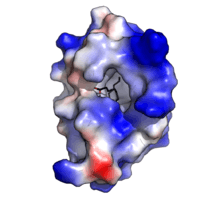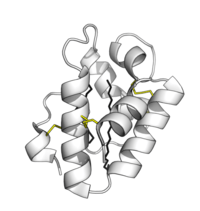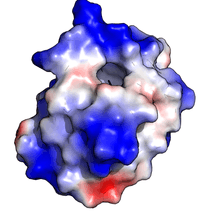Plant lipid transfer proteins
| Plant lipid transfer protein/seed storage/trypsin-alpha amylase inhibitor | |||||||||
|---|---|---|---|---|---|---|---|---|---|
 Oryza sativa Lipid Transfer Protein 1 bound to Palmitic acid (black). Positive charge in blue, negative charge in red. (PDB:1UVB ) | |||||||||
| Identifiers | |||||||||
| Symbol | LTP/seed_store/tryp_amyl_inhib | ||||||||
| Pfam | PF00234 | ||||||||
| InterPro | IPR003612 | ||||||||
| SMART | SM00499 | ||||||||
| |||||||||
Plant lipid transfer proteins, also known as plant LTPs or PLTPs, are a group of highly-conserved proteins of about 9kDa found in higher plant tissues.[1] As its name implies, lipid transfer proteins are responsible for the shuttling of phospholipids and other fatty acid groups between cell membranes.[2] LTPs are also able to bind acyl groups.[2]
Function
Ordinarily, most lipids do not spontaneously exit membranes because their hydrophobicity makes them poorly soluble in water. LTPs facilitate the movement of lipids between membranes by binding, and solubilising them. LTPs typically have broad substrate specificity and so can interact with a variety of different lipids.[3]
LTPs in plants may be involved in:
- cutin biosynthesis
- surface wax formation
- mitochondrial growth
- pathogen defense reactions
- adaptation to environmental changes[4]
Structure



Plant lipid transfer proteins consist of 4 alpha-helices in a right-handed superhelix with a folded leaf topology. The structure is stabilised by disulfide bonds linking the helices to each other.
The structure forms an internal hydrophobic cavity in which 1-2 lipids can be bound. The outer surface of the protein is hydrophilic allowing the complex to be soluble. The use of hydrophobic interactions, with very few charged interactions, allows the protein to have broad specificity for a range of lipids.[3]
Other related proteins
Plant lipid transfer proteins share the same structural domain[5] with seed storage proteins[6] and trypsin-alpha amylase inhibitors.[7][8] These proteins share the same superhelical, disulphide-stabilised four-helix bundle containing an internal cavity.
There is no sequence similarity between animal and plant LTPs. In animals, cholesterylester transfer protein (CETP), also called plasma lipid transfer protein, is a plasma protein that facilitates the transport of cholesteryl esters and triglycerides between the lipoproteins.
Role in human health
PLTPs are pan-allergens, [9] [10] and may be directly responsible for cases of food allergy. Pru p 3, the major allergen from peach, is a 9-kDa allergen belonging to the family of lipid-transfer proteins. [11]
They are used as antioxidants and prevent diseases.
Commercial importance
Lipid transfer protein 1 (from barley) is responsible, when denatured by the mashing process, for the bulk of foam which forms on top of beer.[12]
See also
References
- ↑ http://content.karger.com/ProdukteDB/produkte.asp?Doi=53671
- 1 2 http://arjournals.annualreviews.org/doi/abs/10.1146/annurev.arplant.47.1.627?cookieSet=1&journalCode=arplant.2
- 1 2 Cheng, HC; Cheng, PT; Peng, P; Lyu, PC; Sun, YJ (September 2004). "Lipid binding in rice nonspecific lipid transfer protein-1 complexes from Oryza sativa.". Protein science : a publication of the Protein Society. 13 (9): 2304–15. doi:10.1110/ps.04799704. PMID 15295114.
- ↑ "Science Direct".
- ↑ Bonvin AM, Lyu PC, Samuel D, Cheng CS, Lin KF, Liu YN, Hsu ST (2005). "Characterization and structural analyses of nonspecific lipid transfer protein 1 from mung bean". Biochemistry. 44 (15): –. doi:10.1021/bi047608v. PMID 15823028.
- ↑ Bruix M, Santoro J, Rico M, Gimenez-Gallego G, Pantoja-Uceda D (2003). "Solution structure of RicC3, a 2S albumin storage protein from Ricinus communis". Biochemistry. 42 (47): –. doi:10.1021/bi0352217. PMID 14636051.
- ↑ Fukuyama K, Oda Y, Morimoto T, Matsunaga T, Miyazaki T (1997). "Tertiary and quaternary structures of 0.19 alpha-amylase inhibitor from wheat kernel determined by X-ray analysis at 2.06 A resolution". Biochemistry. 36 (44): –. doi:10.1021/bi971307m. PMID 9354618.
- ↑ Betzel C, Srinivasan A, Singh TP, Gourinath S, Alam N (2000). "Structure of the bifunctional inhibitor of trypsin and alpha-amylase from ragi seeds at 2.2 A resolution". Acta Crystallogr. D. 56 (Pt 3): –. doi:10.1107/s0907444999016601. PMID 10713515.
- ↑ http://www.allergy-clinic.co.uk/food-allergy/food-allergy-guide/
- ↑ http://www.ebi.ac.uk/interpro/IEntry?ac=IPR000528
- ↑ http://www.food-allergens.de/symposium-2-4/peach/peach-allergens.htm Peach allergy, M.Besler et al.
- ↑ http://www.crc.dk/flab/foam.htm